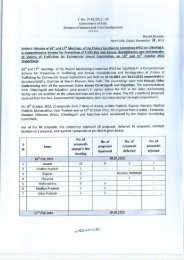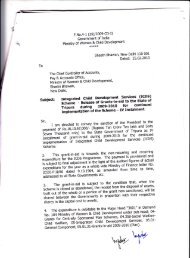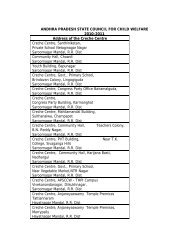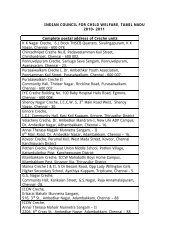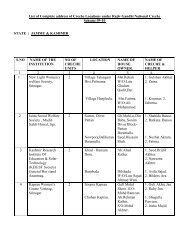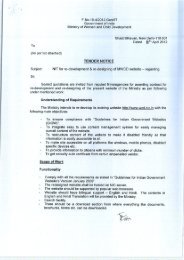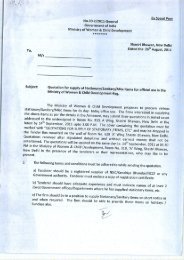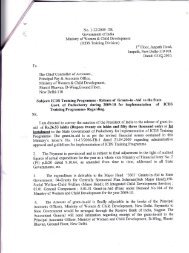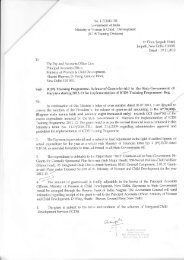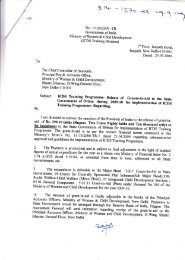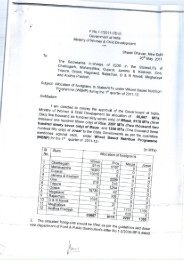COVER HINDI - Ministry of Women and Child Development
COVER HINDI - Ministry of Women and Child Development
COVER HINDI - Ministry of Women and Child Development
- TAGS
- hindi
- ministry
- wcd.nic.in
You also want an ePaper? Increase the reach of your titles
YUMPU automatically turns print PDFs into web optimized ePapers that Google loves.
Box -3<br />
The plan documents have over the years reflected the evolving trends in gender matters. Formal earmarking <strong>of</strong><br />
funds for women began with the <strong>Women</strong>’s Component Plan. However, gender sensitivity in allocation <strong>of</strong> resources<br />
starts with the Seventh Plan<br />
— The Seventh Plan introduced the concept <strong>of</strong> monitoring <strong>of</strong> 27 beneficiary oriented schemes for women by<br />
DWCD. The exercise continues <strong>and</strong> the number <strong>of</strong> schemes covered is being exp<strong>and</strong>ed.<br />
— The Eighth Plan (1992-97) highlighted for the first time a gender perspective <strong>and</strong> the need to ensure a definite<br />
flow <strong>of</strong> funds from the general developmental sectors to women. The Plan document made an express statement that<br />
“….the benefits to development from different sectors should not bypass women <strong>and</strong> special programmes on women<br />
should complement the general development programmes. The later, in turn, should reflect great gender sensitivity”.<br />
— The Ninth Plan (1997-2002) adopted the ‘<strong>Women</strong>’s Component Plan’ as one <strong>of</strong> the major strategies <strong>and</strong><br />
directed both the Central <strong>and</strong> State Governments to ensure “not less than 30 per cent <strong>of</strong> the funds/benefits are<br />
earmarked in all the women’s related sectors. Special vigil advocated on the flow <strong>of</strong> the earmarked funds/benefits<br />
through an effective mechanism to ensure that the proposed strategy brings forth a holistic approach towards<br />
empowering women.<br />
— The Tenth Plan reinforces commitment to gender budgeting to establish its gender-differential impact <strong>and</strong> to<br />
translate gender commitments into budgetary commitments. It states “—the Tenth plan will continue the process <strong>of</strong><br />
dissecting the Government budget to establish its gender –differential impact <strong>and</strong> to translate gender commitments<br />
into budgetary commitments. ——the Tenth Plan will initiate immediate action in tying up these two effective<br />
concepts <strong>of</strong> <strong>Women</strong> Component Plan <strong>and</strong> Gender Budgeting to play a complementary role to each other , <strong>and</strong> thus<br />
ensure both preventive <strong>and</strong> post facto action in enabling women to receive their rightful share from all the women –<br />
related general development sectors.”<br />
— Approach Paper to the Eleventh Plan The Approach Paper to the Eleventh Plan clearly states’ ‘gender<br />
equity requires adequate provisions to be made in policies <strong>and</strong> schemes across Ministries <strong>and</strong> Departments . It also<br />
entails strict adherence to gender budgeting across the board’<br />
Tools <strong>of</strong> Gender Budgeting<br />
6.15 The tools <strong>of</strong> Gender budgeting that have been<br />
disseminated by the MWCD in Workshops/ Orientations,<br />
are indicated below:<br />
a) Guidelines for Gender Sensitive Review <strong>of</strong> Public<br />
Expenditure <strong>and</strong> Policy<br />
Specific guidelines have been formulated by the<br />
<strong>Ministry</strong> <strong>of</strong> <strong>Women</strong> <strong>and</strong> <strong>Child</strong> <strong>Development</strong> in the form<br />
<strong>of</strong> Checklists I <strong>and</strong> II (Box 4 <strong>and</strong> Box 5). Checklist I is for<br />
programmes that are beneficiary oriented <strong>and</strong> consciously<br />
target women. Checklist II covers mainstream sectors.<br />
These guidelines help in reviewing Public expenditure <strong>and</strong><br />
policy from a gender perspective to enable identification<br />
<strong>of</strong> constraints in outreach <strong>of</strong> programmes <strong>and</strong> policies to<br />
cover women <strong>and</strong> to enable suitable corrective action.<br />
b) Gender Based Pr<strong>of</strong>ile <strong>of</strong> Public Expenditure<br />
Preparation <strong>of</strong> the Gender Based pr<strong>of</strong>ile ( Box 6)<br />
facilitates review <strong>of</strong> all schemes <strong>and</strong> public expenditure<br />
from a gender perspective <strong>and</strong> isolating the gender<br />
component by way <strong>of</strong> expenditure <strong>and</strong> physical targets.<br />
The pr<strong>of</strong>ile would give a clear situational analysis <strong>of</strong><br />
constraints like non availability <strong>of</strong> Gender disaggregated<br />
data, need to determine reasons for non adherence to<br />
targeted expenditure on women etc. Trend <strong>of</strong> the gender<br />
component, allocation <strong>and</strong> expenditure, is indicative <strong>of</strong><br />
extent to which budgeting is gender responsive.<br />
Gender Budgeting - Budgeting for Gender Equity 99



